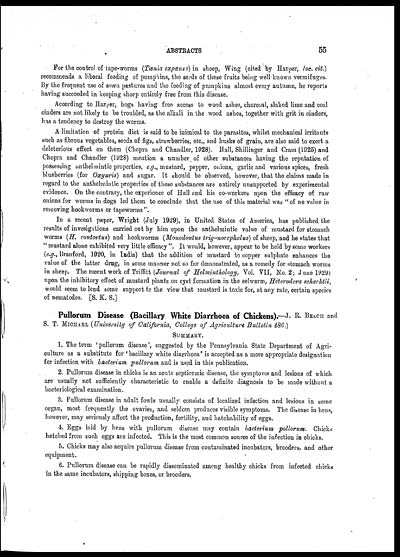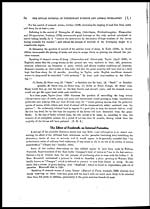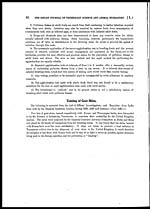Medicine - Veterinary > Veterinary colleges and laboratories > Indian journal of veterinary science and animal husbandry > Volume 1, 1931 > Part I (March 1931) > Abstracts
(89) Page 55
Download files
Individual page:
Thumbnail gallery: Grid view | List view

ABSTRACTS 55
For the control of tape-worms (Tænia expansa) in sheep, Wing (cited by Harper, loc. cit.)
recommends a liberal feeding of pumpkins, the seeds of these fruits being well known vermifuges.
By the frequent use of sown pastures and the feeding of pumpkins almost every autumn, he reports
having succeeded in keeping sheep entirely free from this disease.
According to Harper, hogs having free access to wood ashes, charcoal, slaked lime and coal
cinders are not likely to be troubled, as the alkali in the wood ashes, together with grit in cinders,
has a tendency to destroy the worms.
A limitation of protein diet is said to be inimical to the parasites, whilst mechanical irritants
such as fibrous vegetables, seeds of figs, strawberries, etc., and husks of grain, are also said to exert a
deleterious effect on them (Chopra and Chandler, 1928). Hall, Shillinger and Cram (1925) and
Chopra and Chandler (1928) mention a number of other substances having the reputation of
possessing anthelmintic properties, e.g., mustard, pepper, onions, garlic and various spices, fresh
blueberries (for Oxyuris) and sugar. It should be observed, however, that the claims made in
regard to the anthelmintic properties of these substances are catirely unsupported by experimental
evidence. On the contrary, the experience of Hall and his co-workers upon the efficacy of raw
onions for worms in dogs led them to conclude that the use of this material was "of no value in
removing hookworms or tapeworms".
In a recent paper, Wright (July 1929), in United States of America, has published the
results of invesigations carried out by him upon the anthelmintic value of mustard for stomach
worms (H. contortus) and hookworms (Monodontus trigonocephalus) of sheep, and he states that
" mustard alone exhibited very little efficacy ". It would, however, appear to be held by some workers
(e.g., Branford, 1920, in India) that the addition of mustard to copper sulphate enhances the
value of the latter drug, in some manner not so far demonstrated, as a remedy for stomach worms
in sheep. The recent work of Triffitt (Journal of Helminthology, Vol. VII, No. 2 ; June 1929)
upon the inhibitory effect of mustard plants on cyst formation in the eelworm, Hèterodera schachtii,
would seem to lend some support to the view that mustard is toxic for, at any rate, certain species
of nematodes. [S. K. S.]
Pullorum Disease (Bacillary White Diarrhoea of Chickens).—J. R. BEACH and
S. T. MICHAEL (University of California, College of Agriculture Bulletin 486.)
SUMMARY.
1. The term 'pullorum disease', suggested by the Pennsylvania State Department of Agri-
culture as a substitute for 'bacillary white diarrhoea' is accepted as a more appropriate designation
for infection with bacterium pullorum and is used in this publication.
2. Pullorum disease in chicks is an acute septicemic disease, the symptoms and lesions of which
are usually not sufficiently characteristic to enable a definite diagnosis to be made without a
bacteriological examination.
3. Pullorum disease in adult fowls usually consists of localized infection and lesions in some
organ, most frequently the ovaries, and seldom produces visible symptoms. The disease in hens,
however, may seriously affect the production, fertility, and hatchability of eggs.
4. Eggs laid by hens with pullorum disease may contain bacterium pollorum. Chicks
hatched from such eggs are infected. This is the most common source of the infection in chicks.
5. Chicks may also acquire pullorum disease from contaminated incubators, brooders, and other
equipment.
6. Pullorum disease can be rapidly disseminated among healthy chicks from infected chicks
in the same incubators, shipping boxes, or brooders.
Set display mode to: Large image | Zoom image | Transcription
Images and transcriptions on this page, including medium image downloads, may be used under the Creative Commons Attribution 4.0 International Licence unless otherwise stated. ![]()
| Permanent URL | https://digital.nls.uk/75226061 |
|---|
| Description | Covers articles from 1931. |
|---|




